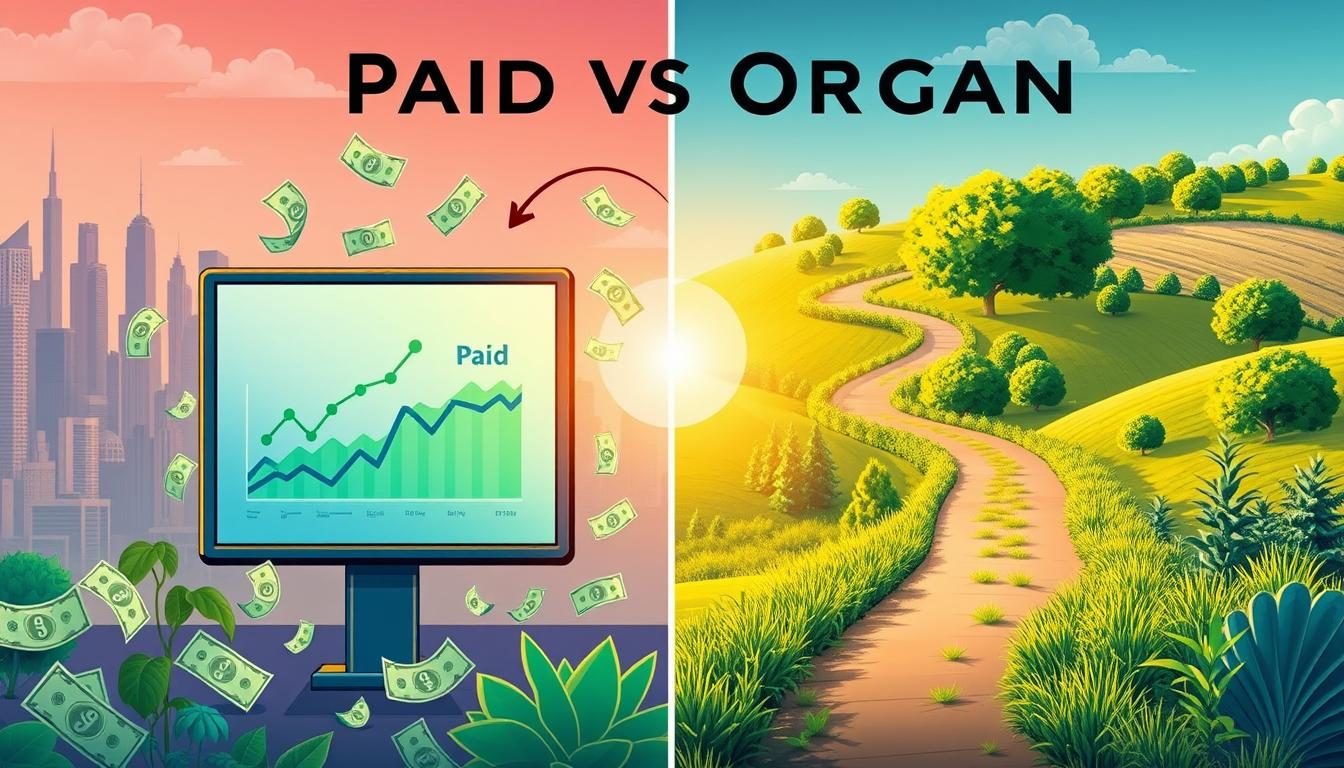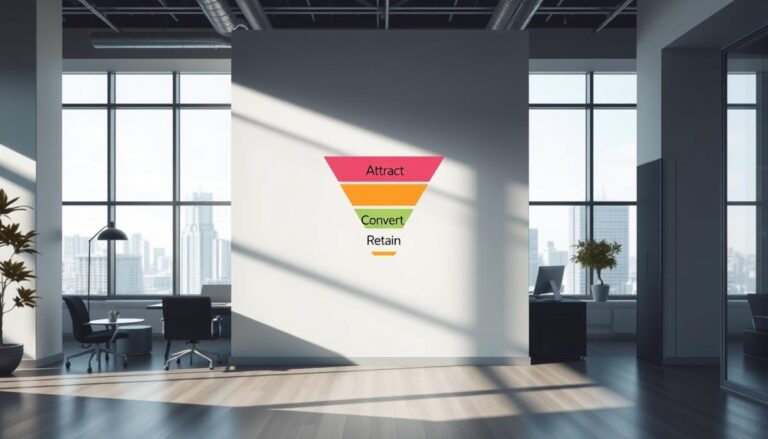Paid vs Organic: Choosing the Right Growth Strategy for Your Business
Businesses often face a tough choice when looking to grow. They must decide between paid marketing and organic marketing. Knowing what each offers is key to making the right choice.
Paid marketing gives you quick visibility and reach. Organic marketing, on the other hand, builds trust and credibility over time. It’s important to pick the strategy that fits your business goals.
Key Takeaways
- Understand the difference between paid and organic marketing strategies.
- Identify your business goals to choose the right growth strategy.
- Consider the unique advantages of each marketing approach.
- Align your marketing strategy with your business objectives.
- Make an informed decision based on your business needs.
Understanding Growth Strategies in Modern Business
In today’s fast-paced digital world, companies are always looking for ways to grow. They want to stay ahead of the competition.
The business world today offers many ways to grow, mainly through paid and organic methods. Knowing the differences between these is key to making smart choices.
Paid growth strategies mean spending money to get more customers and increase sales. In contrast, organic growth strategies aim to build a lasting presence. This is done through content, SEO, and engaging with customers.
Each method has its own benefits and challenges. The secret to success is knowing what your business needs, who your audience is, and the market trends. This helps in picking the best strategy or a mix of them.
What Are Paid Growth Strategies?
Businesses often use paid growth strategies to get noticed fast. These strategies involve direct ads to quickly reach the right people. This helps drive traffic to their websites.
Pay-per-click advertising is a key strategy. Businesses only pay when someone clicks on their ad. This way, ads reach people who might actually be interested in what they offer.
Social Media Advertising
Social media advertising is also very effective. Sites like Facebook, Instagram, and LinkedIn let businesses target ads well. These ads can help drive traffic, get leads, or boost sales.

Social media ads help businesses get more known, engage with customers better, and see how ads do in real-time. Using these platforms can lead to big returns and help businesses grow fast.
In short, strategies like pay-per-click and social media ads help businesses reach their audience and grow. By using these, businesses can get noticed right away and see clear results.
What Are Organic Growth Strategies?
Organic growth strategies are key for businesses wanting a strong online presence. They involve making valuable content and using SEO and social media to grow your brand over time.
Content marketing is a big part of these strategies. By making high-quality, relevant content, businesses can draw in and keep a specific audience.
To get more seen online, businesses need to work on SEO. This means making their website and content better for search engines. This way, more people can find them.
Social media engagement is also very important. By talking to their audience on social media, businesses can create real connections. They can also build a loyal community around their brand.
- Make a content calendar to keep your content regular.
- Do keyword research to make your content better for search engines.
- Chat with your audience on social media by answering comments and messages.
By using these organic growth strategies, businesses can build a lasting online presence. They can also drive growth for the long haul.
Paid vs Organic: Choosing the Right Growth Strategy for Your Business
Understanding the difference between paid and organic strategies is key for business growth. Your choice depends on your goals, budget, and how fast you want to see results.
Budget is a big factor. Paid strategies like ads need a lot of money upfront. Organic methods like SEO or content marketing take time but cost less over time.
Your business goals matter too. Paid strategies work fast for quick wins. But organic growth is better for lasting success.

Think about your timeline too. Paid strategies can show results quickly, in weeks or months. Organic strategies take longer, sometimes a year or more, to really pay off.
Choosing the right strategy means weighing these factors against your business needs. Knowing the pros and cons of paid and organic helps you make a choice that fits your goals and budget.
- Evaluate your budget to determine if paid strategies are feasible.
- Consider your business goals: immediate sales or long-term brand building.
- Assess your timeline: quick results or long-term growth.
By carefully considering these elements, you can pick the best growth strategy for your business. It could be paid, organic, or a mix of both.
When to Prioritize Paid Growth Strategies
Businesses often choose paid growth strategies for quick results. This is true for launching new products, running special offers, or entering tough markets. Paid ads can give the push needed.
Key Scenarios for Paid Growth Strategies:
- Product launches or rebranding efforts
- Limited-time promotions or seasonal sales
- Entering a highly competitive market
- Targeting specific demographics or niches
Paid strategies work well for businesses needing fast visibility. For example, during a product launch, ads can quickly reach more people. This boosts initial sales and creates excitement.
When choosing paid growth, think about your goals, audience, and budget. This helps create focused campaigns. These campaigns can lead to better results and more return on investment.
Benefits of Prioritizing Paid Growth Strategies:
- Immediate visibility and reach
- Targeted advertising to specific demographics
- Measurable ROI and campaign performance
Understanding when to use paid ads helps businesses make smart growth plans. This leads to success in their markets.
When to Focus on Organic Growth
Organic growth strategies are great for building a loyal customer base and boosting brand credibility. They help businesses lay a strong foundation for lasting success.
The benefits of organic marketing are many. It helps businesses connect deeply with their audience, building trust and loyalty. Organic growth is also more lasting, based on real interactions and relationships, not just ads.
To make the most of organic growth, focus on creating top-notch, relevant content. This could be blog posts, social media, or community-building efforts. Doing this helps increase your brand’s visibility and credibility, leading to long-term growth.
- Developing a robust content marketing strategy
- Engaging with customers on social media
- Optimizing website content for search engines
- Building a loyal community through consistent interaction
By using these strategies, businesses can enjoy the perks of organic growth. This includes better brand credibility and a loyal customer base. This approach supports long-term growth and builds a sustainable business model.
Creating a Hybrid Approach: Balancing Paid and Organic
The best marketing plans mix paid and organic methods. This blend offers quick results from paid efforts and lasting growth from organic strategies. It helps businesses build a strong online presence.
A hybrid approach uses each strategy’s strengths. Paid marketing boosts visibility and traffic fast. Organic marketing builds a solid base for long-term success.
To mix paid and organic well, follow these steps:
- Know your main goals: Do you need quick traffic or long-term brand growth?
- Plan your budget: Decide how much for paid ads and organic efforts.
- Keep an eye on results: Check how paid and organic campaigns do and tweak as needed.
Using a hybrid strategy, businesses get the best of both. For example, a company can use paid social media ads to increase website visits. At the same time, they work on making their site better for organic search.
The secret to a winning hybrid strategy is making sure paid and organic work together. This way, businesses can get more online visibility, more traffic, and meet their marketing targets.
Balancing paid and organic marketing needs constant tweaking and knowing your audience well. But, when done right, it can lead to big growth and a strong online presence.
Conclusion
Deciding between paid and organic growth is key for businesses wanting to grow online. Knowing the good and bad of each helps make smart choices. This matches their goals and what they can afford.
Using a mix of both paid and organic marketing is often the best plan. It lets businesses get quick wins from ads while building a strong online base. This way, they get the best of both worlds.
Choosing between paid and organic marketing isn’t just yes or no. Businesses need to think about their needs, goals, and what they have. This helps them make a marketing plan that works for the long haul.
This summary shows how important it is to be flexible and adaptable in marketing. As the online world changes, businesses must be ready to change their strategies too. This keeps them ahead in the game.
FAQ
What is the main difference between paid and organic growth strategies?
Paid growth means paying for ads to get quick results. Organic growth is about building a lasting online presence through content and social media.
How do I choose between paid and organic growth strategies for my business?
Your choice depends on your goals, budget, and how fast you need results. Think about your audience, what you want to achieve, and how competitive your market is.
What are the benefits of using paid growth strategies?
Paid strategies like ads offer quick visibility and targeted reach. They’re great for new product launches or special offers.
How can organic growth strategies help my business?
Organic strategies build a lasting online presence and connect with your audience. They help build your brand and are good for long-term relationships.
Can I use both paid and organic growth strategies together?
Yes, combining both can be effective. It balances quick results from paid ads with the long-term benefits of organic growth.
How do I measure the success of my growth strategy?
Track website traffic, engagement, and conversion rates. Also, look at your return on investment. Use this data to improve your strategy.
What are some common mistakes to avoid when choosing a growth strategy?
Don’t ignore your audience or marketing goals. Also, track your results and avoid relying too much on one strategy. A mix of both can be best.






